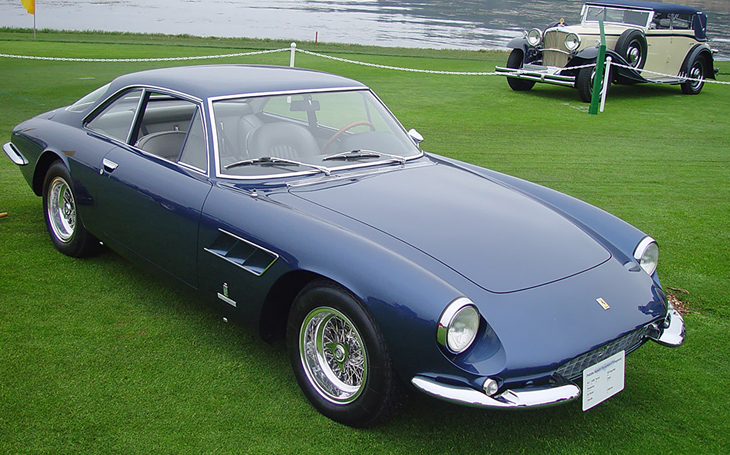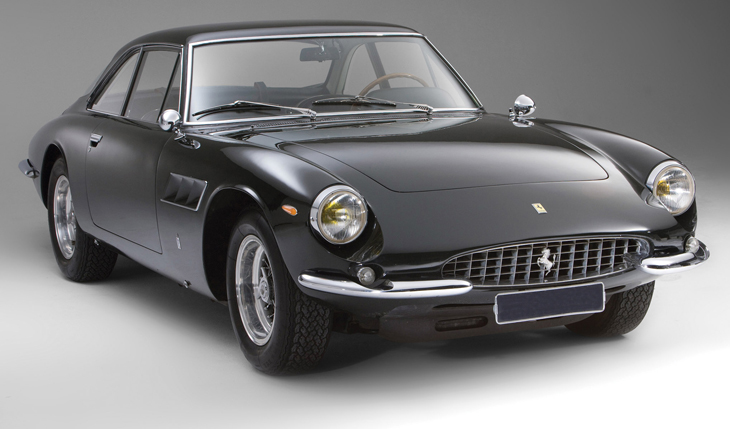|
The 500 Superfast was presented at the 1964 Geneva Salon, and would have a limited production run into 1966. It would also be the last low volume production coupé produced by Ferrari, in a series that had started
with the America and Superamerica of the fifties and early sixties. As the series production car output increased in number and uniformity, the tooling necessary for small series runs was becoming less viable, despite the
greater sales price.
A total of thirty-six examples were produced in the chassis number range 05951SF to 08897SF, whilst a one-off 330 GT 2+2 (chassis 06267) was produced with a Superfast-style body for HRH Prince
Bernhard of The Netherlands. Clients for this exclusive form of transportation, which cost as much as two Rolls Royce when new, included the Shah of Iran (who bought two within four months in 1965) and the British actor Peter
Sellers.
The body was designed by Pininfarina, and bore striking similarities to the 400 SA Coupé Aerodinamico. It had a large, shallow oval radiator grille opening, with open headlights in deep wing recesses as
standard, although two examples received Plexiglass covers.
A long sweeping bonnet ran into an airy cabin section with slim roof pillars, from which the rear screen flowed into the boot line, terminating in a neat
shallow oval Kamm tail. The tail lights were horizontal, bullet-shaped assemblies with three individual circular lenses to each unit, unique to this model. Wrap-around chrome-plated quarter bumpers were fitted front and rear:
those at the front with shallow recesses for the circular side/turn lights (apart from the first car in the series which had shallow elliptical flush lights above the bumper).
Early examples in the series had 11-slot
engine bay exhaust vents in the front wings, succeeded later by a triple louvre assembly, as had happened on the 330 GT 2+2 and 275 GTS models. Despite the change to alloy wheels as standard to Ferrari road cars of the period,
the 500 Superfast was fitted with 7L x 15" Borrani wire wheels throughout the production run.
The bodies were mounted on a 2650 mm wheel base chassis that had the factory reference number 578, and all were numbered in
the odd chassis number road car sequence carrying an 'SF' suffix. This was the last series of Ferrari cars to carry chassis number suffix letters.
The chassis and its ancillary components were very similar in
construction to that of the concurrent 330 GT 2+2 model, with a tubular steel frame, independent front suspension, rigid rear axle with leaf springs and telescopic shock absorbers, four wheel disc brakes, with separate front
and rear hydraulic circuits, and either left- or right-hand drive: eight examples being produced in the latter form.
As with the 400 Superamerica, the number in the model designation referred to the total cubic capacity
of the engine (in the case of the 500 Superfast, five litres), rather than the swept volume of an individual cylinder. The engine was a single overhead camshaft per bank V12 unit, with factory type reference 208, a total cubic
capacity of 4,963 cc, and a bore and stroke of 88 x 68 mm. There was an outside the vee spark plug arrangement, a bank of three twin choke Weber 40 DCZ/6 carburettors, and a twin coil and rear of engine-mounted distributor
ignition system that produced a claimed 400 bhp.
The engine was unique to this model, with bore centres of 108 mm, which had been used on the earlier Lampredi 'long' block engine. This was the only common ground,
however; otherwise the design was based on the original Colombo 'short' block. The engine was coupled to a 4-speed, all synchromesh gearbox, with an electronically operated overdrive fifth gear on early cars, and to a 5-speed,
all synchromesh gearbox on late models.
Cars fitted with a 4-speed gearbox had a mechanically actuated clutch, whilst 5-speed cars were provided with a hydraulically operated unit.
Engine
- Type front, longitudinal 60° V12
- Bore/stroke 88 x 68 mm
- Unitary displacement 413.58 cc
- Total displacement 4962.96 cc
- Compression ratio 8.8 : 1
- Maximum power 294 kW (400 hp) at 6500 rpm
- Power per litre 81 hp/l
- Valve actuation single overhead camshaft per bank, two valves per cylinder
- Fuel feed six Weber 40 DCZ/6 carburettors
- Ignition single spark plug per cylinder, two coils
- Lubrication wet sump
- Clutch single-plate
Chassis
- Frame tubular steel
- Front suspension independent, unequal-length wishbones, coil springs, telescopic shock absorbers, anti-roll bar
- Rear suspension live axle, twin radius arms, semi-elliptic springs, coil springs over telescopic shock absorbers
- Brakes discs
- Transmission 4-speed + overdrive + reverse
- Steering worm and sector
- Fuel tank capacity 100 litres
- Front tyres 205 x 15
- Rear tyres 205 x 15
Bodywork
- Type two-seater coupé
- Length 4820 mm
- Width 1730 mm
- Height 1280 mm
- Wheelbase 2650 mm
- Front track 1397 mm
- Rear track 1389 mm
- Weight 1400 kg (dry)
Performance







< 1960's
|







